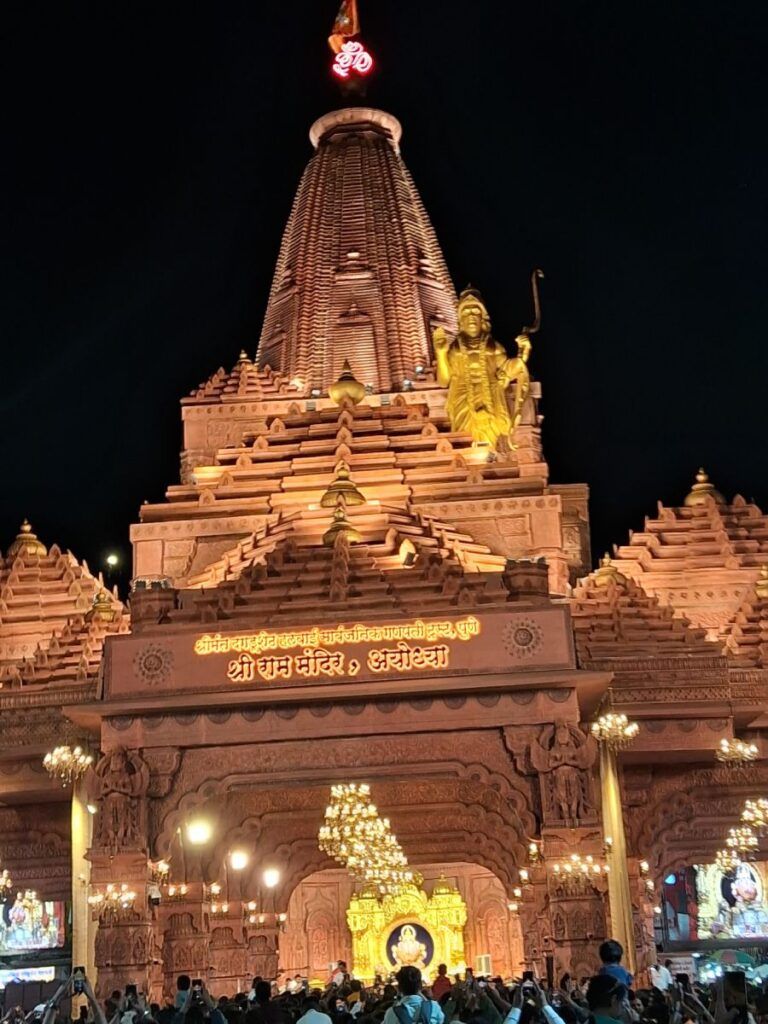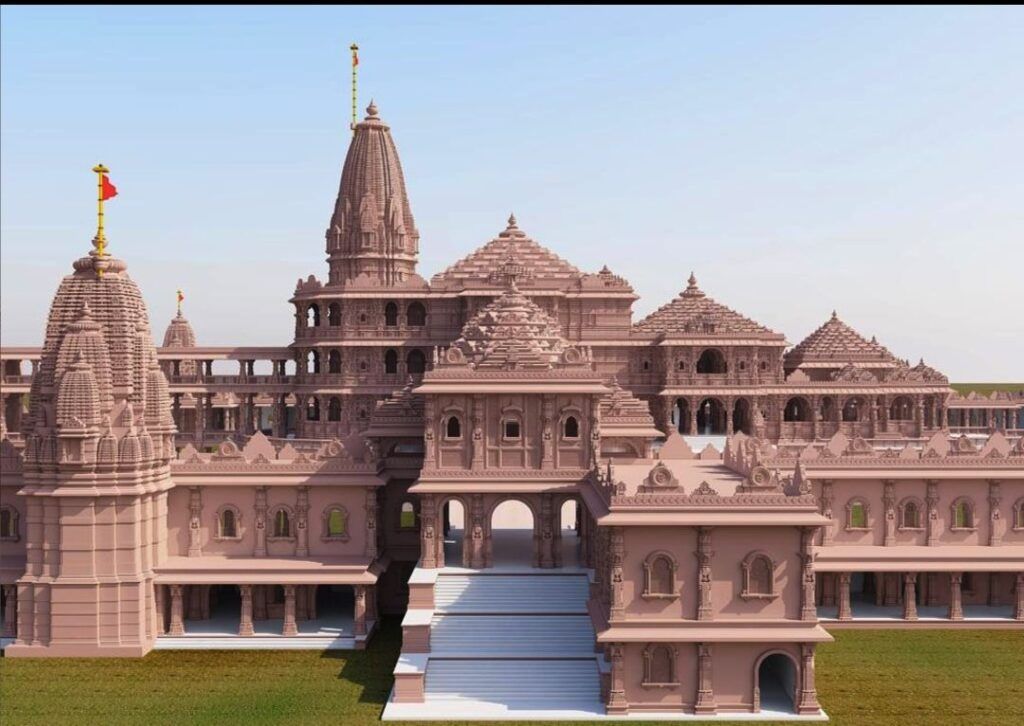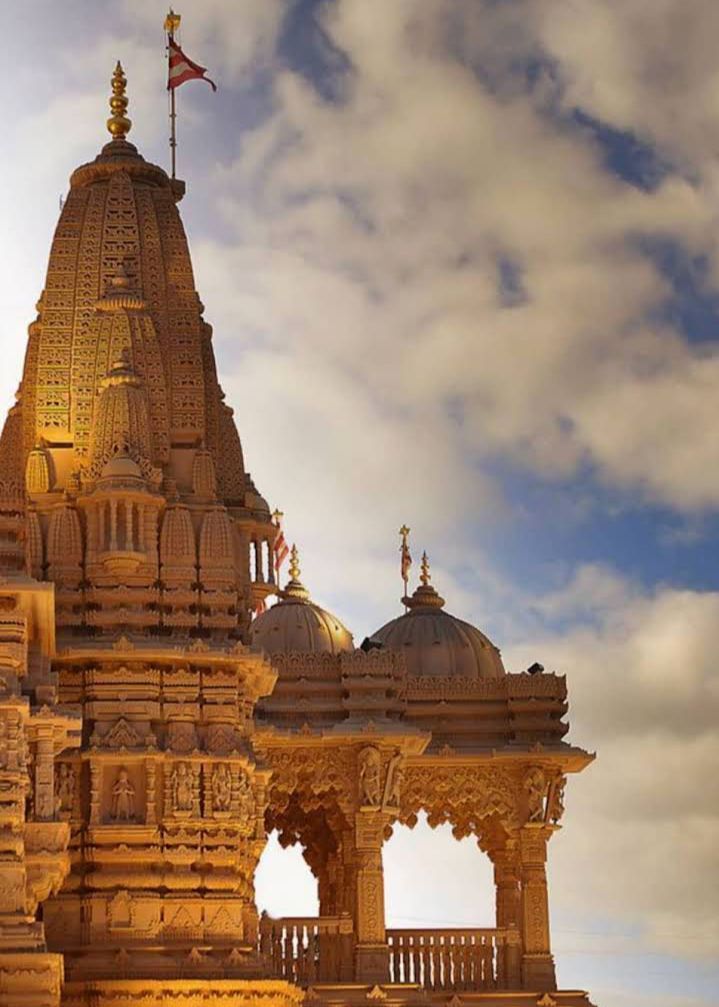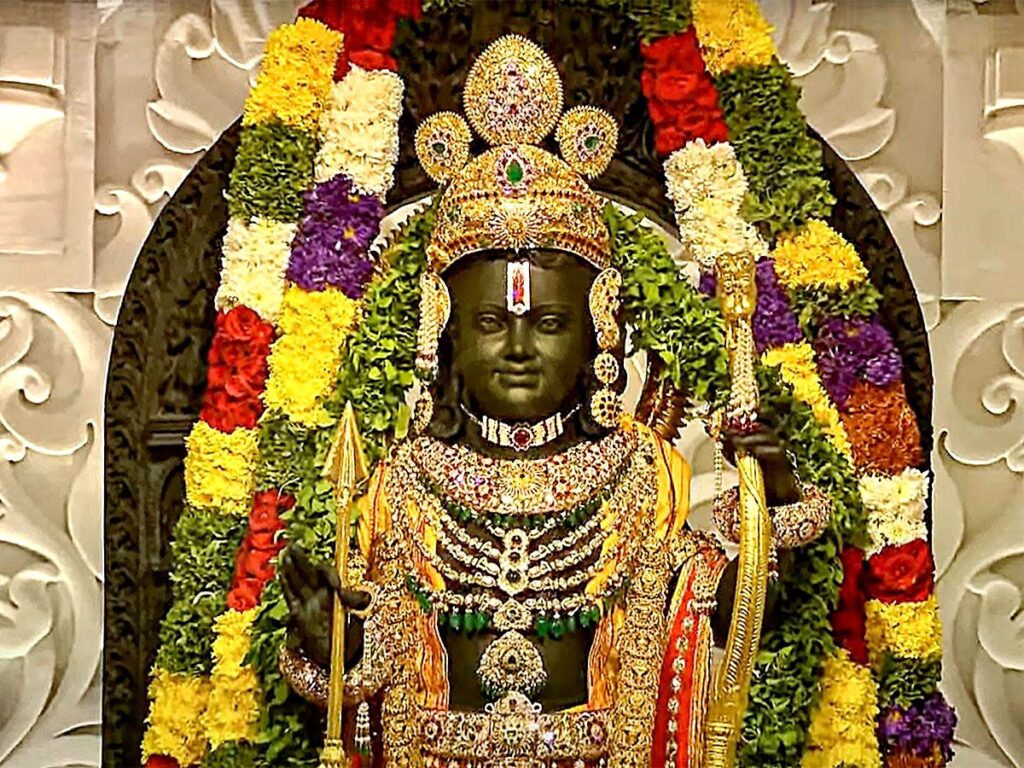Ram Mandir Ayodhya | Shri Ram Janmabhoomi
The Ram Mandir in Ayodhya, Uttar Pradesh, India, is a Hindu temple under construction at the site of Ram Janmabhoomi, the hypothesized birthplace of Rama, a principal deity of Hinduism. The site is the former location of the Babri Masjid.

Contents
- 1 History of Ram Mandir Ayodhya:
- 2 Significance of Ram Mandir Ayodhya:
- 3 Legend of Ram Mandir Ayodhya:
- 4 Myths of Ram Janmabhoomi:
- 5 Architecture of Ram Mandir Ayodhya:
- 6 Miracles of Ram Mandir Ayodhya:
- 7 Ram Mandir Ayodhya Temple Timing:
- 8 Places to visit near Ram Janmabhoomi:
- 9 FAQ:
- 10 How to reach Ram Mandir Ayodhya:
- 11 Google Maps:
History of Ram Mandir Ayodhya:
The history of the Ram Mandir Ayodhya is a complex and contentious one. The site is believed to be the birthplace of Lord Rama, one of the most revered Hindu deities. In the 16th century, the Mughal emperor Babur built a mosque, the Babri Masjid, on the site.
For centuries, Hindus and Muslims worshipped at the site peacefully. However, in the late 19th century, tensions between the two communities began to rise. In 1885, a Hindu Mahant filed a lawsuit in court, seeking to build a temple on the site. The case dragged on for decades, and in 1949, a group of Hindu activists stormed the mosque and damaged it.
In 1961, the mosque was locked by the government, and neither Hindus nor Muslims were allowed to worship there. In 1984, the Vishwa Hindu Parishad (VHP), a Hindu nationalist organization, launched a campaign to build a Ram temple on the site. The campaign gained momentum in the late 1980s, and in 1992, a mob of Hindu activists demolished the Babri Masjid.
The demolition of the Babri Masjid sparked widespread violence and communal tensions across India. Thousands of people were killed in the riots that followed. The Indian government appointed a commission to investigate the demolition, but the commission’s report was never released.
In 1994, the Supreme Court of India ordered the government to acquire the land surrounding the disputed site and to maintain the status quo. The case remained dormant for many years, but in 2010, the court ordered the Archaeological Survey of India to conduct an excavation at the site.
The excavation found evidence of a pre-existing Hindu structure at the site. However, the court did not rule on whether the structure was a temple. In 2019, the Supreme Court finally ruled on the case, awarding the land to the Hindus for the construction of a temple. The court also ordered the government to provide alternative land to the Muslims for the construction of a mosque.
The construction of the Ram Mandir Ayodhya began in 2020 and is expected to be completed in 2023. The temple is expected to be one of the largest and most magnificent Hindu temples in the world.
The history of the Ram Mandir Ayodhya is a complex and painful one. It is a story of religious conflict, violence, and injustice. However, it is also a story of hope and resilience. The construction of the Ram Mandir Ayodhya is a sign of the growing confidence and assertiveness of the Hindu community in India.
Explore More Temples>> Ambaji Temple: The Power of Shakti

Significance of Ram Mandir Ayodhya:
The Ayodhya Temple is significant for a number of reasons.
- Religious significance: For Hindus, the Ram Mandir Ayodhya is a sacred site and a symbol of their faith. Rama is one of the most revered deities in Hinduism, and his birthplace is considered to be a holy place. The construction of the Ram Mandir Ayodhya is seen as a way to honor Rama and to reclaim a sacred site that had been lost to Hindus for centuries.
- Cultural significance: The temple at Ayodhya is also a symbol of Hindu culture and heritage. The Ramayana, the epic that tells the story of Rama’s life, is one of the most important works of Hindu literature. The Ram Mandir Ayodhya is seen as a way to celebrate the Ramayana and to preserve Hindu culture and heritage.
- National significance: The Ram Mandir Ayodhya has also become a symbol of national significance in India. The dispute over the site has been one of the most divisive issues in Indian politics for decades. The construction of the Ram Mandir Ayodhya is seen by many Hindus as a victory for their community and a sign of the growing importance of Hinduism in India.
The construction of the Ram Mandir Ayodhya is a significant event for Hindus all over the world. It is a symbol of their faith, their culture, and their national identity.
In addition to the above, the Ayodhya temple is also expected to have a number of other benefits, such as:
- Economic benefits: The construction of the Ram Mandir Ayodhya is expected to boost the economy of Ayodhya and the surrounding region. The temple is expected to attract millions of pilgrims every year, which will generate revenue for hotels, restaurants, and other businesses.
- Social benefits: The construction of the Ram Mandir Ayodhya is also expected to have a number of social benefits. It is expected to promote peace and harmony between Hindus and Muslims. The temple is also expected to create jobs and opportunities for people in the region.
Explore More Temples>> Where are Shakti Peethas Located?

Legend of Ram Mandir Ayodhya:
The legend of the Ram Mandir in Ayodhya is a complex and controversial one. Hindus believe that the site is the birthplace of Lord Rama, the seventh avatar of the god Vishnu. Muslims, on the other hand, believe that the site was once the location of a mosque called the Babri Masjid.
The conflict over the Ram Mandir site dates back to the 16th century, when the Mughal emperor Babur is said to have demolished a Hindu temple to build the Babri Masjid on its ruins. Hindus have long claimed that the Babri Masjid was built on the site of Lord Rama’s birthplace, and they have been demanding that the mosque be demolished and a temple be built in its place.
In the 1980s, the Hindu nationalist Vishwa Hindu Parishad (VHP) launched a movement to build a Ram Mandir at the site of the Babri Masjid. The movement gained momentum in the early 1990s, and in December 1992, a mob of Hindu kar sevaks (activists) demolished the Babri Masjid.
The demolition of the Babri Masjid sparked widespread violence across India, and hundreds of people were killed. The Indian government responded by imposing a curfew in Ayodhya and deploying security forces to the area.
In 1994, the Indian Supreme Court ordered that the status quo at the site be maintained, meaning that no construction could take place on the land. The case has been dragging on ever since, with both sides claiming ownership of the site.
In 2019, the Indian Supreme Court ruled in favor of the Hindus, awarding them the disputed land. The court also ordered the government to provide a suitable plot of land to the Muslims to build a new mosque.
The construction of the Ram Mandir is currently underway, and it is expected to be completed in 2023. The temple is expected to be a major tourist attraction and a place of pilgrimage for Hindus from all over the world.
The legend of the Ram Mandir is a powerful one, and it has played a significant role in Indian history and politics. The conflict over the site has been a source of tension and violence between Hindus and Muslims for centuries. The construction of the ayodhya temple is a major event in Indian history, and it is likely to have a significant impact on the country’s future.
Explore More Temples>> Chilkur Balaji Temple (Visa Balaji): Where Wishes Come True

Myths of Ram Janmabhoomi:
There are a number of myths and legends associated with the Ram Mandir in Ayodhya, India. Some of the most popular myths include:
- The birthplace of Lord Rama: Hindus believe that the Ram Mandir is the birthplace of Lord Rama, the seventh avatar of Vishnu. According to the Ramayana, Lord Rama was born to King Dasharatha and Queen Kausalya in the city of Ayodhya.
- The construction of the Ram Mandir by Vikramaditya: Some Hindus believe that the Ram Mandir was originally constructed by the legendary emperor Vikramaditya in the first century BC. However, there is no historical evidence to support this claim.
- The destruction of the Ram Mandir by Babur: In 1528, the Mughal emperor Babur ordered the construction of a mosque, known as the Babri Masjid, at the site of the Ram Mandir. Hindus believe that the Babri Masjid was built on the ruins of a Hindu temple.
- The demolition of the Babri Masjid: In 1992, a mob of Hindu activists demolished the Babri Masjid. This event led to widespread violence and communal riots across India.
- The construction of the new Ram Mandir: In 2020, the Supreme Court of India ruled that the Ram Mandir should be rebuilt at the site of the Babri Masjid. The construction of the new Ram Mandir is currently underway.
In addition to these myths, there are a number of other stories and legends associated with the Ram Mandir. For example, some Hindus believe that the ayodhya temple is located on a powerful energy vortex. Others believe that the temple is home to a number of hidden treasures.
It is important to note that these myths and legends are not based on historical evidence. However, they play an important role in the Hindu faith and culture. The Ram Mandir is one of the most important Hindu pilgrimage sites in the world, and it is a symbol of Hindu faith and identity.
Here are some additional myths about the Ram Mandir:
- The Ram Mandir is the center of the universe.
- The Ayodhya Temple is a place where miracles happen.
- The Ram Mandir is a gateway to heaven.
- The Ayodhya Temple is the source of all creation.
- The Ram Mandir is the embodiment of Lord Rama himself.
Explore More Temples>> Titwala Ganesh Mandir: Where Devotion Meets Serenity

Architecture of Ram Mandir Ayodhya:
The Ram Mandir in Ayodhya, India is being built in the Nagara style of temple architecture. The Nagara style is one of the two major styles of Hindu temple architecture, the other being the Dravidian style. The Nagara style is characterized by its soaring spires (shikharas) and its intricate carvings.
The Ram Mandir will have a three-story structure with a towering central shikhara that will be 161 feet tall. The temple will also have five mandapas (halls) and a number of smaller shrines. The mandapas will be used for various purposes, such as worship, prayer, and community gatherings.
The temple is being built using pink sandstone and white marble. The exterior of the temple will be decorated with intricate carvings of Hindu deities, symbols, and geometric patterns. The interior of the temple will be simple and elegant, with a focus on the worship of Lord Rama.
The Ram Mandir is one of the most anticipated temple projects in the world. It is expected to be completed in 2024 and is expected to attract millions of pilgrims from all over the world.
Here are some of the key features of the Nagara style of temple architecture that are incorporated into the design of the Ram Mandir:
- Soaring shikhara: The shikhara is the tallest and most prominent element of a Nagara temple. The shikhara of the Ram Mandir will be 161 feet tall and will be topped with a kalasha (finial).
- Intricate carvings: The exterior of a Nagara temple is typically decorated with intricate carvings of Hindu deities, symbols, and geometric patterns. The Ram Mandir will be decorated with carvings of Lord Rama, his family and friends, and scenes from the Hindu epic Ramayana.
- Raised platform: Nagara temples are typically built on a raised platform, called a jagati. The jagati symbolizes the sacredness of the temple and elevates it above the surrounding area. The Ram Mandir will be built on a raised platform that is 10 feet high.
- Multiple mandapas: Nagara temples typically have multiple mandapas (halls). The mandapas are used for various purposes, such as worship, prayer, and community gatherings. The Ram Mandir will have five mandapas:
- Kudu mandapa: This is the main entrance mandapa. It is named after the kudu (mythical lion) sculptures that adorn its pillars.
- Nritya mandapa: This mandapa is used for dance performances.
- Rang mandapa: This mandapa is used for theatrical performances.
- Kirtan mandapa: This mandapa is used for singing and chanting.
- Prarthana mandapa: This mandapa is used for prayer and meditation.
The Ram Mandir is a beautiful and impressive example of the Nagara style of temple architecture. It is a testament to the rich cultural heritage of India and the deep devotion of Hindus to Lord Rama.
Explore More Temples>> Bhadrachalam Shri Ram Temple | Bhadradri Seetha Ramachandra Swamy

Miracles of Ram Mandir Ayodhya:
The Ram Mandir in Ayodhya is one of the most important Hindu pilgrimage sites in the world. It is believed to be the birthplace of Lord Rama, the seventh avatar of Vishnu. The temple is also believed to be a place where miracles happen.
Here are some of the miracles that are reported to have happened at the Ram Mandir:
- The self-manifested idol of Lord Rama: The idol of Lord Rama that is enshrined in the Ram Mandir is said to have appeared miraculously. In the 16th century, a Muslim priest named Mir Baqi built a mosque on the site of the Ram Mandir. However, in 1949, a group of Hindu devotees discovered an idol of Lord Rama beneath the floor of the mosque. The idol is believed to have appeared miraculously.
- The healing powers of the temple: The Ram Mandir is also known for its healing powers. Devotees come to the temple from all over the world to seek relief from various ailments. Many people have reported being healed of their illnesses after visiting the temple.
- The miraculous appearance of water: In 2002, there was a severe drought in Ayodhya. The water level in the Saryu River, which flows through Ayodhya, had fallen drastically. Devotees prayed to Lord Rama for rain. Miraculously, the water level in the river started to rise and the drought was averted.
- The miraculous appearance of flowers: In 2003, a group of devotees were visiting the Ram Mandir when they saw flowers blooming on the idol of Lord Rama. The flowers were blooming even though it was not the flowering season. The devotees took this as a sign of the miraculous powers of Lord Rama.
Explore More Temples>> Divine Sri Bhramaramba Mallikarjuna Swamy Temple Srisailam
Ram Mandir Ayodhya Temple Timing:
The Ram Mandir Ayodhya temple is currently under construction, but it is expected to open to the public in 2024. The timings of the temple have not been officially announced yet, but it is likely to be open from 6:00 AM to 12:00 PM and from 4:00 PM to 9:00 PM.
Once the temple is open, it is expected to be a major pilgrimage site for Hindus from all over the world. The temple is dedicated to Lord Rama, who is one of the most revered Hindu deities.
Places to visit near Ram Janmabhoomi:
Hanuman Garhi: This is a prominent temple dedicated to Lord Hanuman and is located near the Ram Mandir. It is situated on a hill and offers a panoramic view of Ayodhya.
Kanak Bhawan: Also known as Sone-ka-Ghar, this temple is dedicated to Lord Ram and Goddess Sita. The interiors of the temple are adorned with gold and silver decorations.
Treta Ke Thakur: This temple is said to be the spot where Lord Ram was crowned as the king of Ayodhya. It is an important religious site for devotees.
Swarg Dwar: Swarg Dwar, which means “Heavenly Door,” is believed to be the spot where Lord Ram is said to have entered heaven. It’s an important pilgrimage site.
Guptar Ghat: This ghat on the banks of the Sarayu River is a serene place for a dip and some quiet reflection. It’s considered a holy spot.
Tulsi Smarak Bhawan: Dedicated to the renowned poet-saint Tulsidas, this museum showcases his life and works.
Ramkatha Park: A beautifully landscaped garden dedicated to the life and teachings of Lord Ram. It often hosts light and sound shows depicting the Ramayana.
Ram Janmabhoomi: The birthplace of Lord Ram is another important site in Ayodhya. While the Ram Mandir is now the primary focus, the original Janmabhoomi area is preserved and can be visited.
Hanonmanpuri Temple: A temple dedicated to Lord Hanuman, where it is believed he spent some time during Lord Ram’s exile.
Bahu Begum ka Maqbara: This historical site is the tomb of Bahu Begum, the wife of the third Nawab of Awadh, Nawab Shuja-ud-Daula. It’s an architectural marvel.
Explore More Temples>> Shirdi Sai Baba Temple Maharashtra
FAQ:
Q: Where is the Ram Mandir located?
A: The Ram Mandir is located in Ayodhya, Faizabad district, Uttar Pradesh, India. Ayodhya is a holy city for Hindus and is believed to be the birthplace of Lord Rama.
Q: What is the Ram Mandir dedicated to?
A: The Ram Mandir is dedicated to Lord Rama, the seventh avatar of Vishnu. Lord Rama is one of the most popular and revered Hindu deities.
Q: What is the history of the Ram Mandir?
A: The history of the Ram Mandir is complex and controversial. The site of the Ram Mandir is believed to be the birthplace of Lord Rama, and Hindus have been worshipping at the site for centuries. However, in the 16th century, a mosque, the Babri Masjid, was built on the site.
In 1992, Hindu activists demolished the Babri Masjid, claiming that it had been built on the site of a Hindu temple. This led to widespread riots and violence across India. In 2019, the Supreme Court of India ruled that the Ram Mandir should be rebuilt on the site, and the Babri Masjid should be rebuilt on a different site.
Q: What is the status of the Ram Mandir construction?
A: The construction of the Ram Mandir began in August 2020 and is expected to be completed in 2024. The temple is being built on a 5-acre plot of land that was awarded to the Shri Ram Janmabhoomi Teerth Kshetra Trust by the Supreme Court.
Q: How can I donate to the Ram Mandir construction?
A: There are a number of ways to donate to the Ram Mandir construction. You can donate online, through bank transfer, or by sending a cheque or demand draft to the Shri Ram Janmabhoomi Teerth Kshetra Trust.
Q: When will the Ram Mandir be open to the public?
A: The Ram Mandir is expected to be open to the public in 2024, once the construction is completed.
Q: What are the things to see and do in Ayodhya?
A: In addition to the Ram Mandir, there are a number of other things to see and do in Ayodhya, including:
- The Kanak Bhawan Temple: This temple is dedicated to Lord Rama and his wife, Sita.
- The Nageshwar Nath Temple: This temple is dedicated to Lord Shiva.
- The Hanuman Garhi Temple: This temple is dedicated to Lord Hanuman.
- The Saryu River: This river flows through Ayodhya and is considered to be sacred.
- The Ayodhya Museum: This museum houses a collection of artifacts related to the history of Ayodhya.
How to reach Ram Mandir Ayodhya:
By Air:
The nearest major airport is the Chaudhary Charan Singh International Airport in Lucknow, which is approximately 140 kilometers away from Ayodhya. You can take a domestic flight to this airport and then proceed to Ayodhya by road.
By Train:
Ayodhya has its own railway station, known as Ayodhya Junction. It is well-connected to major cities across India. You can check the train schedule and book tickets to Ayodhya Junction.
By Road:
Ayodhya is accessible by road from various cities in Uttar Pradesh and neighboring states. You can use state-run buses, private buses, or hire a taxi to reach Ayodhya.
Local Transportation:
Once you reach Ayodhya, you can use local transportation options like auto-rickshaws, cycle-rickshaws, and taxis to get to the temple site.
